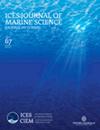使用 Δ 方法模拟热带金枪鱼围网捕捞浮体副渔获物的丰度
IF 3.4
2区 农林科学
Q1 FISHERIES
引用次数: 0
摘要
兼捕率对于估计渔业影响和做出管理决策至关重要,但有关兼捕的数据往往很有限。热带金枪鱼围网(PS)渔业捕获大量副渔获物,包括脆弱的丝鲨。即使副渔获物比例相对较低,由于这些渔业规模庞大,对中上层生态系统的影响可能也很重要。对兼捕渔获物的部分观察覆盖是评估影响的主要障碍。在此,我们开发了一种通用的 Δ 建模方法,用于预测 2011 年至 2018 年期间法属印度洋 PS 船队浮游物相关渔组中包括丝鲨在内的四种主要副渔获物的渔获量,该方法基于日志和观测数据。交叉验证和变量选择被用来确定最佳模型,这些模型由随机森林模型(用于存在-不存在)和负二项泛加模型(用于存在时的丰度)组成。尽管模型能解释小到中等数量的变异(5-15%),但它们优于通常用于报告的更简单的方法,并使我们能以稳健的不确定性估计来估算四个物种的年度混获总量。有趣的是,顶级掠食者相对于平均渔获量的不确定性低于饵料物种,这与这些物种与金枪鱼相似的行为和生态位相一致。本文章由计算机程序翻译,如有差异,请以英文原文为准。
Modeling bycatch abundance in tropical tuna purse seine fisheries on floating objects using the Δ method
Bycatch rates are essential to estimating fishery impacts and making management decisions, but data on bycatch are often limited. Tropical tuna purse seine (PS) fisheries catch numerous bycatch species, including vulnerable silky sharks. Even if bycatch proportion is relatively low, impacts on pelagic ecosystems may be important due to the large size of these fisheries. Partial observer coverage of bycatch is a major impediment to assessing impacts. Here we develop a generic Δ modeling approach for predicting catch of four major bycatch species, including silky sharks, in floating object-associated fishing sets of the French Indian Ocean PS fleet from 2011 to 2018 based on logbook and observer data. Cross-validation and variable selection are used to identify optimal models consisting of a random forest model for presence–absence and a negative binomial general-additive model for abundance when present. Though models explain small to moderate amounts of variance (5–15%), they outperform a simpler approach commonly used for reporting, and they allow us to estimate total annual bycatch for the four species with robust estimates of uncertainty. Interestingly, uncertainty relative to mean catch is lower for top predators than forage species, consistent with these species having similar behavior and ecological niches to tunas.
求助全文
通过发布文献求助,成功后即可免费获取论文全文。
去求助
来源期刊

ICES Journal of Marine Science
农林科学-海洋学
CiteScore
6.60
自引率
12.10%
发文量
207
审稿时长
6-16 weeks
期刊介绍:
The ICES Journal of Marine Science publishes original articles, opinion essays (“Food for Thought”), visions for the future (“Quo Vadimus”), and critical reviews that contribute to our scientific understanding of marine systems and the impact of human activities on them. The Journal also serves as a foundation for scientific advice across the broad spectrum of management and conservation issues related to the marine environment. Oceanography (e.g. productivity-determining processes), marine habitats, living resources, and related topics constitute the key elements of papers considered for publication. This includes economic, social, and public administration studies to the extent that they are directly related to management of the seas and are of general interest to marine scientists. Integrated studies that bridge gaps between traditional disciplines are particularly welcome.
 求助内容:
求助内容: 应助结果提醒方式:
应助结果提醒方式:


